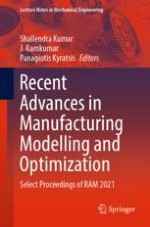2022 | OriginalPaper | Chapter
Numerical Modeling of Die-sinking EDM for Evaluation of Material Removal Rate and Surface Roughness
Authors : B. M. Barua, S. Chang, E. Shylla, V. S. Chauhan, P. Kumar, M. Rahang, D. K. Sarma
Published in: Recent Advances in Manufacturing Modelling and Optimization
Publisher: Springer Nature Singapore
Activate our intelligent search to find suitable subject content or patents.
Select sections of text to find matching patents with Artificial Intelligence. powered by
Select sections of text to find additional relevant content using AI-assisted search. powered by
